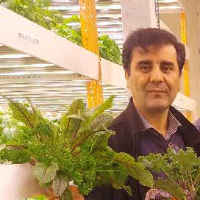Effects of Salinity Stress on Morphological and Physiological Characteristics of some Local Landrace and Inter specific Hybrids of Cucurbits Seedlings as Rootstocks
Author(s):
Article Type:
Research/Original Article (دارای رتبه معتبر)
Abstract:
Introduction
Salinity stress is regarded as one of the most important abiotic factors in plant limiting growth, particularly in arid and semi-arid regions. The reduction of plant growth by salinity stress has been well documented. When water supply is limited, plant structure is modified by increasing the root: shoot ratio. To reduce of losses in vegetative growth and production of plant and to improve water use efficiency under saline conditions in high-yielding genotypes grafting them onto rootstocks could bereduced the effect of saline stress on plant shoot. Grafting is a routine technique in continuous cropping systems. Most of the species of cucurbits are distributed in the dry regions. The objective of this studywas investigated the effectiveness of salinity stress on accessions of cucurbita and hybrid inter specific which enter from another country to Iran.Materials And Methods
This research was conducted in laboratory and greenhouse at the Research Center of Agricultural and Natural Resources of Isfahan during 2013-2014 growing season. A factorial experiment based on completely randomized design with three replications was conducted for rootstock and irrigation water salinity.. In the first experiment 25 seeds of rootstocks were sown in petri dishes with 10 cm diameter and irrigated by 10 ml of saline water. Rootstocks included 20 different local landraces and interspecific hybrids (C.moschata cv. Isfahan and Koshk, C.pepo cv. Alvar, Tiran, Koshk and Asgharabad, C. maxima cv. Kermanshah, Shahreza, Mohamadiyeh and Alvar, Lagenaria Siceraria, Luffa cylindrica, Trichosanthes cucumerina, RZ-Ferro, Es113, Ews910, Ews909, Ews913, 426 and Es152). Salinity stress was 6 levels (0, 2, 4, 6, 8 and 10 ds/m of NaCl). Germination, diameter of stem, height of root and stem, shoot and root fresh mass, vigor index and root: shoot ratio were evaluated. In the second experiment seeds were sown in plastic pot by soil media. Seedlings were irrigated daily with 200 ml of saline water (0, 2 and 4 ds/m) for 35 days. Excess solution was allowed to drain from the plants through drainage holes in the base of the pots. Hybrids of 152,426 and Trichosanthes cucumerina, Luffa cylindrical and Cucurbita pepo con. Pepo var. Styriaca was added. In the second phase measured shoot and root dry mass, SPAD index, relatively water content and seedling vigor index.Results And Discussion
the results showed that all parameters were significantly influenced by salinity except root: shoot ratio in Petri dish. Salinity stress reduced chlorophyll index (SPAD), relative water content in cucurbita leaves than control (without saline) and also seeds germination, seedlings fresh mass and seedlings vigour by 51%, 53%, and 75 % respectively. .The shoot dry biomass of local landrace and inter specific hybrids in both experiment decreased linearly in response to increasing saline stress. Recorded data in Petri dish and plastic pot were significantly influenced by rootstock, whereas no significant difference was observed on germination rate and vigor index for plastic pot in greenhouse. The lowest seed germination percentage, seedling growth, vigor index and root: shoot ratio recorded on high saline concentration. NaCl threshold damage to cucurbits was evaluated 4 ds/m. Populations of C. maxima cv.Kermanshah and Shahreza, C.moschata cv. Isfahan and inters pecific hybrids Ferro, 909 and 910 were showed tolerant to salinity. It is proven that crop growth decreases with increasing saline stress (Rouphael, et al., 2012). Hybrids of C. moschata cv. Koshk, C. pepo cv. Koshk and Asgharabad, Lagenaria Siceraria, Es113 and Cucurbita pepo con. Pepo var. Styriaca were sensitive to saline stress. Kumar et al, (2008) also reported plant response to salinity depends on type of salt, salt concentration and plant genotype.Conclusions
Salinity stress adversely affect biomass and leaf water content of cucurbita. Our results indicated that local and hybrid cucurbit plants exhibited different response to saline stress. Hybrid rootstocks 909, 910 and Ferro were tolerant to salinity. Although local landrace C. maxima. cv. Shahreza and Kermanshah, C. moschata cv. Isfahan and C. pepo cv. Tiran were tolerant to salinity. Sensitivity to saline stress was similar between some local landrace and hybrid plants. Finally, after grafting in cucurbita rootstocks needs more research to use water, wast water, NaCl and other resources of salinity and to find the most tolerant rootstock.Keywords:
Language:
Persian
Published:
Journal of horticulture science, Volume:31 Issue: 2, 2017
Pages:
292 to 305
magiran.com/p1781599
دانلود و مطالعه متن این مقاله با یکی از روشهای زیر امکان پذیر است:
اشتراک شخصی
با عضویت و پرداخت آنلاین حق اشتراک یکساله به مبلغ 1,390,000ريال میتوانید 70 عنوان مطلب دانلود کنید!
اشتراک سازمانی
به کتابخانه دانشگاه یا محل کار خود پیشنهاد کنید تا اشتراک سازمانی این پایگاه را برای دسترسی نامحدود همه کاربران به متن مطالب تهیه نمایند!
توجه!
- حق عضویت دریافتی صرف حمایت از نشریات عضو و نگهداری، تکمیل و توسعه مگیران میشود.
- پرداخت حق اشتراک و دانلود مقالات اجازه بازنشر آن در سایر رسانههای چاپی و دیجیتال را به کاربر نمیدهد.
In order to view content subscription is required
Personal subscription
Subscribe magiran.com for 70 € euros via PayPal and download 70 articles during a year.
Organization subscription
Please contact us to subscribe your university or library for unlimited access!




